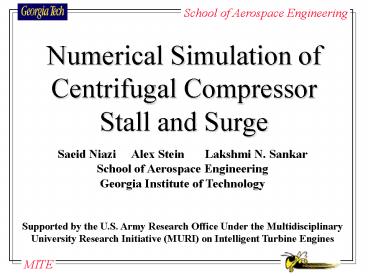Numerical Simulation of Centrifugal Compressor Stall and Surge - PowerPoint PPT Presentation
1 / 25
Title:
Numerical Simulation of Centrifugal Compressor Stall and Surge
Description:
Title: Numerical Simulation of Centrifugal Compressor Author: Sankar Last modified by: CFD Lab Created Date: 1/5/1998 9:30:42 PM Document presentation format – PowerPoint PPT presentation
Number of Views:73
Avg rating:3.0/5.0
Title: Numerical Simulation of Centrifugal Compressor Stall and Surge
1
Numerical Simulation of Centrifugal Compressor
Stall and Surge
Saeid Niazi Alex Stein Lakshmi N. Sankar School
of Aerospace Engineering Georgia Institute of
Technology Supported by the U.S. Army Research
Office Under the Multidisciplinary University
Research Initiative (MURI) on Intelligent Turbine
Engines
2
Overview
- Motivation and Objectives
- Mathematical Formulation
- Boundary Conditions
- Simulation Setup
- Results
- Design and Off-Design Condition Validations
- Stall Control (Bleed Valve)
- Conclusions
- Future Work
3
Motivation and Objectives
With Control
?p
- Centrifugal Compressors Are Widely Used in Many
Practical Applications (Rotorcraft,
Turbomachinery, Tanks)
Without Control
.
m
- Develop a Numerical Scheme to Model and
Understand Compressor Stall Surge. - Explore Active Passive Control Strategies to
Extend Useful Operating Range of Compressor.
4
MATHEMATICAL FORMULATION
Reynolds Averaged Navier-Stokes Equations in
Finite Volume Representation
where,
q is the state vector. E, F, and G are the
inviscid fluxes, and R, S, and T are the viscous
fluxes. A cell-vertex finite volume formulation
using Roes scheme is used for the present
simulations.
5
MATHEMATICAL FORMULATION
A four point stencil is used to compute the
inviscid flux terms at the cell faces as shown
below
Stencil for q right
Stencil for q left
Right
Left
i-1 i i1 i2
Cell face i1/2
This makes the scheme third-order accurate in
space.
6
MATHEMATICAL FORMULATION
- The viscous fluxes are computed to second order
spatial accuracy. - A three-factor ADI scheme with second-order
artificial damping on the LHS is used to advance
the solution in time. The scheme is first-order
accurate in time. - The Spalart-Allmaras turbulence model is used in
the present simulations.
7
NASA Low Speed Centrifugal Compressor
SIMULATION SETUP
- 20 Full Blades with 55 Backsweep
- Inlet Diameter 0.87 m
- Exit Diameter 1.52 m
- Design Conditions
- Mass Flow Rate 30 kg/sec
- 1862 RPM
- Total Pressure Ratio 1.14
8
Single Passage Grid Modeling
SIMULATION SETUP
Grid Size 65x31x21 42315 points
9
SIMULATION SETUP
Boundary Conditions
Inlet p0,T0,v,w specified Riemann-Invariant
extrapolated from Interior
Exit pback specified all other quantities
extrapolated from Interior
Periodic Boundaries Properties are averaged on
either side of the boundary
Solid Walls no-slip velocity conditions p r
extrapolated from Interior
10
Blade Pressure at Different Span Stations
RESULTS (Design Conditions)
Good Agreement Between CFD and Experiment
11
Blade Pressure at Different Span Stations
RESULTS (Design Conditions)
Good Agreement Between CFD and Experiment
12
Blade Pressure at Different Span Stations
RESULTS (Design Conditions)
Slight Difference Between CFD and Experiment Due
to Tip Vortex
13
Shroud Pressure Distribution Near Blades
RESULTS (Design Conditions)
14
Shroud Pressure Distribution
RESULTS (Design Conditions)
Pressure Increases Along Blade Passage
15
Impeller Performance Characteristic
RESULTS (Design Off-Design)
16
Relative Velocity (Colored by Pressure)
RESULTS (Design Conditions)
Flow is Well Attached.Very Small Regions of
Separation Occur Near Shroud Wall (Enlarged View)
17
Relative Velocity (Colored by Pressure)
RESULTS (Design Conditions)
Diffuser Region is Well BehavedNo Separation
18
RESULTS (Off-Design Conditions)
Relative Velocity (Colored by Pressure)
Diffuser Region Shows Small SeparationOnset of
Instabilities
19
RESULTS (Off-Design Conditions)
Relative Velocity (Colored by Pressure)
Diffuser Region Completely SeparatedDiffuser
Stall Occurs
20
RESULTS (Design Off-Design)
Comparison Between Design Off-Design
21
RESULTS (Bleed Valve)
Relative Velocity Colored by Pressure
Bleeding Greatly Improves Flow BehaviorDiffuser
Stall is Suppressed
22
RESULTS (Bleed Valve)
Effects of Diffuser Bleeding
23
RESULTS (Bleed Valve)
Effects of Diffuser Bleeding
Bleeding Reduces Reverse Flow in Compressor Exit
Plane
24
CONCLUSIONS
A 3-D unsteady compressible flow solver for
modeling centrifugal compressors has been
developed and validated. Good agreement with
experiments have been obtained for a Low Speed
Centrifugal Compressor (LSCC) tested at NASA
Lewis Research Center. For the LSCC
instabilities were found to originate in the
diffuser region. Stall and surge may be
eliminated by the use of bleed valves on the
diffuser walls.
25
FUTURE WORK
- Continue to work on control issues, e.g. unsteady
bleeding, recirculation. - Development and implementation of unsteady
boundary conditions. - Apply compressor code to centrifugal compressor
with higher pressure ratios.































